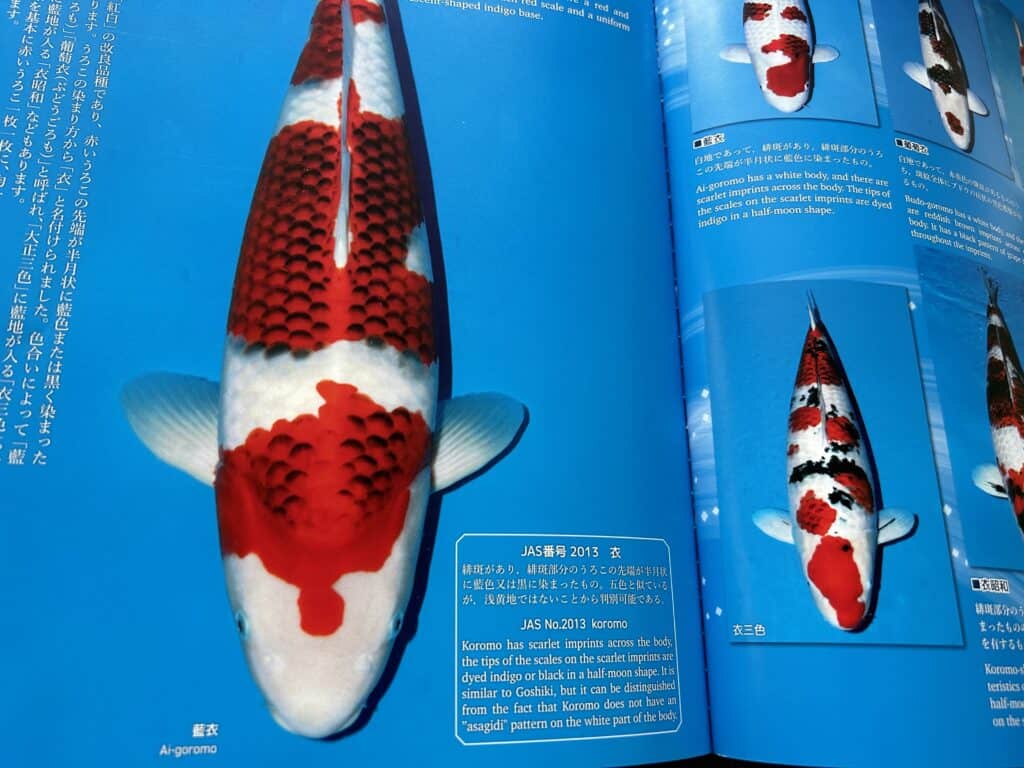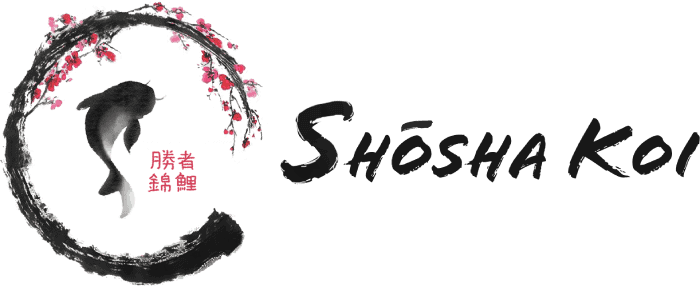Koi Terminology Part I

Koi Terminology Part I
Ever wondered what Motoguro means ? Or was it Tejima... Don't know your Kin from your Gin ?
Check out the Koi terminology list below. Some you will read of or hear every day in your hobby, other words you may never come across.
Last updated 10/09/2023
Aka – (AH kah) Entire red body
Aka hana – (AH kah HAH nah) Red nose
Akame – (AH kah may) The red iris in the eye of an albino koi. Often seen in Kigoi
Akebi – (ah KEH bee) light blue
Ami – (ah ME) Net
Amime – (ah ME meh) Mesh or scales in a net pattern
Aragoke – (ah rah GO keh) Large armour or plate scales
Atama – (ah TAH mah) Head crown
Ato – (AH toh) Late-appearing usually referring to sumi that often develop later than other colours
Beni – (BEN ee) Describes deep solid red. Often used in the Go-Sanke varieties.
Beta-gin – (BEH tah deen) a type of gin-rin scale, where the whole scale sparkles
Boke – (BOH kee) Undeveloped Showa sumi
Bozu – (boh ZOO) No hi on the head, bald head
Budo – (BOO doh) A pattern of colored scales resembling a bunch of grapes
Danmoyo – (dahn MOW yow) A stepped pattern
Doh – (doh) Body
Doitsu – (DOYTs) also called German koi that are not fully scaled, usually with a row of large plate scales along each lateral line and a row on either side of the dorsal fin
Fucarin – (FOO kah reen) The area of skin between the scales giving a ‘golf ball’ like appearance
Fukurin – (FOO koo reen) Mesh pattern or reticulated effect (vignette) involving scales and skin
Giku –(GEE koo) Relates to the swimming mode of a koi with a deformed body.
Gin – (geen) Shiny, reflective, silver metallic.
Ginrin or Gin-Rin – (geen reen) Refers to sparkling scales, often called diamond scales
Godan – (GOH dahn) Five step pattern
Goi – (goy) Fish
Goke – (GOH keh) Fish scale
Gotenzakura – (goh tehn ZAH koo rah) Cherry pattern
Hachi – (HAH chee) Head
Hara – (hah RAH) Abdominal area
Hi – (HEE) A term for red, not typically used when discussing Go-Sanke. Often used for variety names i.e. Hi-Showa, Hi Utsuri etc.
Hikari – (hee KAH ree) Metallic. i.e. the metallic seen on a Yamabuki.
Hikarimono – (hee KAH ree MOH noh) Single-coloured metallic koi, such as Kin Matsuba
Hikarimoyo – (hee KAH ree MOH yoh) Multicolored metallic koi, such as Kujaku
Hikari-moyomono – (hee KAH ree MOH yoh MOH noh) A classification including all metallic koi with two or more colors, except metallic Utsuri and Showa
Hikarimuji – (hee KAH ree MOO gee) Single-coloured metallic koi used more so for varieties such as Mukashi Ogon, Yamabuki etc.
Ichimatsu – (EE chee maht soo) Checkered pattern
Inazuma – (EE nah ZOO mah) Lighting strike pattern
Ippon hi – (EE pohn HEE) A continuous red pattern from head to tail
Iro – (EE row) Colour
Jari – (JAH ree) Literally means gravel
Jarisumi – (JAH ree SOO mee) Small black sumi spots
Kabuto – (kah BOO toh) Means ‘helmet’. Refers to a koi with a head colour that is different from its body
Kana – (KAH nah) Male koi
Katamoyo – (KAH tah MOH yoh) A pattern that is present only on one side of the body
Kawagoi – (KAH wah goy) A koi with no scales except for some reflective scales on the dorsal surface
Kawarimono – (kah WAH ree MOH noh) All non-metallic koi that don’t fit into any other classification
Kawarigoi – (kah WAH ree goy) The new term for Kawarimono
Kin – (keen) Metallic gold
Kindai – (keen DYE) Modern
Kin Gin-Rin – (keen geen deen) also known as Gin-Rin (geen deen) Koi with silver or gold-colored sparkling scales
Kiwa – (KEE wah) The trailing edge of a pattern
Koke – (KOH keh) Scale
Kokenami – (KOH keh NAH mee) Line of scales
Kuchi – (KOO chee) Lips
Kuchibeni – (KOO chee BEN eee) A koi with red lips
Kutsubera – (KOO tsoo beh RAH) Shoehorn or U-shape pattern on the head
Magoi – (MAH goy) Mud carp, originally wild carp
Maruten – (MOH roo ten) A separate, self contained hi (red) pattern on the head with other hi patterns on the body
Menkaburi – (MEHN kah BOO ree) Hi (red) covering the entire face or head
Menware – (MEHN wah reh) Traditional black head patterns of Showa and Utsuri
Motoaka – (MOH toh AH kah) Red markings at the base of the pectoral fins
Motocha – (MOH toh chah) Brown markings at the base of the pectoral fin
Motoguro – (MOH toh GOO roh) Black markings at the base of the pectoral fins
Namikin – (nah MEE keen) The caudal or tail fin
Namitate – (nah MEE tah teh) Dorasl Fin
Nishikigoi – (nee SHEE kee goy) ‘Jewelled’ carp
Nisai – (NEE sye) A koi in its second year – up to two years old
Odome – (oh DOH meh) Last marking before the tail
Ojime – (oh GEE meh) Gap between the last pattern marking and the tail
Ozuke – (oh ZOO keh) The base of the tail
Pongoi – (POHN goy) Good quality fish
Rin – (deen) Scale
Sansai – (SAHN sye) A koi in its third year – up to three years old
Sashi – (SAH shee) The leading edge of a pattern element
Shimi – (SHEE mee) Undesirable, small black spots or dots, no larger than a single scale
Shiroji – (shee ROH gee) White area
Sokozumi – (SOH koh ZOO mee) Black that is faintly visible
Sumi – (SOO mee) Black marking
Take – (TAH ky) Means expensive. Usually used to describe the breeders most expensive Koi.
Tategoi – (TAH teh goy) A koi that possess potential for the future
Tateshita – (TAH teh shee tah) Young koi that has finished developing and has no potential for improvement. the opposite of Tategoi
Tebire – (teh BEE reh) Pectoral fin
Tejima – (teh GEE mah) Sumi stripes in the fins
Tosai – (TOH sye) A koi in its first year – up to one year old
Tsuya – (TSOO yah) Luster
Wagoi – (WAH goy) Scaled koi
Yogyo – (YOHG yoh) Young fish
Yonsai – (YAHN sye) A koi in its fourth year, up to four years old
